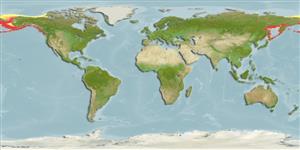>
Salmoniformes (Salmons) >
Salmonidae (Salmonids) > Salmoninae
Etymology: Salvelinus: Old name for char; it is the same root of german "saibling" = little salmon (Ref. 45335); malma: malma which is the the common name for this species in Kamchatka (Ref. 1998).
Eponymy: Dolly Varden is a character in Charles Dickens’ Barnaby Rudge (1841). [...] (Ref. 128868), visit book page.
More on author: Walbaum.
Environment: milieu / climate zone / depth range / distribution range
Sinh thái học
Biển; Nước ngọt; Thuộc về nước lợ Sống nổi và đáy; di cư biển sông (để đẻ trứng) (Ref. 51243); Mức độ sâu 0 - 200 m (Ref. 50550). Temperate; 4°C - 18°C (Ref. 13614); 75°N - 38°N, 127°E - 123°W
North America: Arctic and Pacific drainages from lower Mackenzie River in Northwest Territories, Canada to Puget Sound and Quinault River in Washington, USA (Ref. 86798). Northwest Pacific: Korea to Bering Sea (Ref. 2850).
Length at first maturity / Bộ gần gũi / Khối lượng (Trọng lượng) / Age
Maturity: Lm 23.5, range 12 - 21 cm
Max length : 127 cm TL con đực/không giới tính; (Ref. 27436); common length : 37.5 cm TL con đực/không giới tính; (Ref. 12193); Khối lượng cực đại được công bố: 18.3 kg (Ref. 27436)
Các tia vây lưng cứng (tổng cộng) : 0; Các vây lưng mềm (tổng cộng) : 10 - 16; Tia cứng vây hậu môn: 0; Tia mềm vây hậu môn: 10 - 15. Body elongate, somewhat rounded, greatest body depth below dorsal fin. Head rather long. Pelvic fins with free-tipped fleshy appendage above its insertion. Caudal emarginate (Ref. 27547). Color varies with size, locality and habitat. Sea-run adults with back, upper head, and upper sides dark blue, the sides silvery to white. In freshwater populations, the back and upper sides are olive green to brown, the sides a paler color but bright red in spawning fish and at all times in some areas of Alaska, the underside white to dusky. The dorsal surface are marked with yellow, orange or red spots, more numerous and those along the lateral line smaller, than in arctic char. Spawning males, especially of anadromous populations, turn red on the ventral surface and tip of snout. The lower jaw, operculum and parts of the head are black, the back and sides turn olive-brown. The spots become more vivid orange-red, the pectoral and anal fins red-black with a white leading edge, the snout thickens and the lower jaw turns up. Females change less.
Occurs in deep runs and pools of creeks and small to large rivers; also in lakes and the sea (Ref. 5723, 86798). Lives in very clean mountain streams (Ref. 12218). Nerito-pelagic (Ref. 58426). Typically anadromous, but many populations are landlocked. Anadromous fish may spend 2-3 years at sea, evidently near shore, migrate upstream usually in fall, and spawn during spring (Ref. 86798). Young remain in streams for 3-4 years and feed on insects, leeches, snails, and salmon eggs (Ref. 1998) before entering brackish and salt water to feed on insects, fishes, and other invertebrates. Utilized fresh and eaten fried, broiled, and baked (Ref. 9988).
Adults from the sea and lakes enter rivers to spawn. A female selects a nest site and begins to dig a redd while the male continues to court her and drive away intruding males. Upon completion of the redd, both drop into it and release eggs and sperm. This may be repeated several times before the eggs are covered by the female who swims along the edge of the of the redd, sweeping small pebbles and other particles into it with her tail and anal fin. Later, she may dig again and further cover the eggs while preparing a new nest (Ref. 27547). Breeding is an annual event for southern populations; occurring every second or third year in the Arctic (Ref. 27547). Males and females reportedly die after spawning (Ref. 12218).
Page, L.M. and B.M. Burr, 2011. A field guide to freshwater fishes of North America north of Mexico. Boston : Houghton Mifflin Harcourt, 663p. (Ref. 86798)
IUCN Red List Status (Ref. 130435: Version 2024-2)
Threat to humans
Harmless
Human uses
Các nghề cá: Tính thương mại; cá để chơi: đúng
Các công cụ
Special reports
Download XML
Các nguồn internet
Estimates based on models
Preferred temperature (Ref.
123201): 0.2 - 8, mean 2.2 °C (based on 653 cells).
Phylogenetic diversity index (Ref.
82804): PD
50 = 0.5000 [Uniqueness, from 0.5 = low to 2.0 = high].
Bayesian length-weight: a=0.00589 (0.00394 - 0.00879), b=3.04 (2.92 - 3.16), in cm total length, based on LWR estimates for this species & (Sub)family-body (Ref.
93245).
Mức dinh dưỡng (Ref.
69278): 4.4 ±0.6 se; based on diet studies.
Thích nghi nhanh (Ref.
120179): thấp, thời gian nhân đôi của chủng quần tối thiểu là 4.5 - 14 năm (tm=3-5).
Prior r = 0.24, 95% CL = 0.16 - 0.36, Based on 1 data-limited stock assessment.
Fishing Vulnerability (Ref.
59153): High to very high vulnerability (70 of 100).
Nutrients (Ref.
124155): Calcium = 6.82 [4.19, 11.37] mg/100g; Iron = 0.282 [0.177, 0.452] mg/100g; Protein = 18.1 [16.8, 19.6] %; Omega3 = 1.08 [0.46, 2.78] g/100g; Selenium = 13.9 [4.8, 42.4] μg/100g; VitaminA = 22.3 [7.0, 74.9] μg/100g; Zinc = 0.523 [0.395, 0.693] mg/100g (wet weight);
